INTRODUCTION
Globally there is a significant increase in avocado production linked to the special interest in the 'Hass' cultivar. In 2010, the recorded production was 3,810,459 t, while in 2020, production reached 8,059,359 t (FAO, 2022). Within this trend, Colombia shows a great growth in the areas destined to 'Hass' avocado production, going from 13,000 ha in 2015 to more than 30,000ha in 2021 (MADR, 2021).
Despite this expansions, existing data in Colombia on the ecophysiology and productivity of 'Hass' avocado under the conditions of the Colombian Andean tropics are limited (Arias et al., 2021). It is urgent to establish solid scientific and technical information bases to sustain the growth and the projection of this fruit crop in the country. Also considering that in some avocado growing regions the expansion is having environmental impacts (Magrach and Sanz, 2020).
Numerous studies have shown that 'Hass' avocado production has several limitations, among them, flower drop, poor fruit set, small and large fruit drop, changes in fruit quality (Alcaraz and Hormaza, 2014; Henao-Rojaset al., 2019). In addition,there is the phenomenon of alternate bearing which implies abundant harvests followed by scarce harvests (Lovatt, 2010). It has even been shown that within the same tree, depending on the quadrant, there may be differences in the behavior of buds, flowers and fruit production (Aounallah et al., 2017; Kviklys et al., 2022).
The effect of light intensity, temperature and relative humidity on the tree's microclimate can alter its growth (Wen et al., 2018). In the avocado, the different solar radiation intensity in the canopy is other of the factors limiting production (Alon et al., 2022). Changes in light intensity due to the cloud cover can generate alterations in the tree's photosynthetic machinery (Pattemore et al., 2018). Environmental temperature has an effect on flower opening and closing, flower induction and organogenesis, pollen germination and pollen tube growth (Dixon and Sher, 2002; Alcaraz et al., 2011; Davenport, 2011; Acosta-Rangel et al., 2021). As for air humidity, it can affect pollen germination and growth (Lahav and Zamet, 1999), as well as fruit retention (Salazar-García et al., 2016).
The aim of this study was to determine the effect of photosynthetically active radiation (PAR), ambient temperature, relative humidity and cardinal position of the inflorescences on the retention and final growth of 'Hass' avocado fruits in two contrasting zones of the Andean tropics of Colombia.
MATERIALS AND METHODS
The study was conducted in two commercial orchards located in different altitudinal zonesin the department of Caldas, Colombia, Villamaría at 2,400 m a.s.l. (5º01'05'' N 75°29'54.9"W) classified as a humid cold climate (CH)according to the Caldas-Lang classification, and Aranzazu at 1,900 m a.s.l. (5º18'40'' N; 75°29’13.1 “W) with semi-humid temperate climate (Tsh). The study spanned from January 2021 to February 2022. Four ‘Hass’ avocado trees between 5 and 7 years old were marked per orchard, and inflorescences, flowers and fruits were marked on each quadrant of the tree. The soils of the two orchards have a lo‘my t’xture (Soil Survey Staff, 1999) and the agricultural management fulfilled the guidelines of the Colombian Agricultural Institute (ICA 2016; 2017).
The four trees selected displayed homogeneity in their growth and production values, and their distribution in the orchard was random considering that the topography of the land (was flat in the two zones). On each tree, twenty inflorescences were marked, distributed in five per quadrant, and for each inflorescence all the flowers were counted and the fruits retained per inflorescence were monitored through time and until the moment of harvest. The inflorescences were observable with plastic strips, and the fruits were marked with clamps at their marble-sized stage.
For the measurement of climatic variables in the tree canopy (Aounallah et al., 2017), an EliTech RC-51H datalogger (EliTech, Paris) was used to record air humidity and ambient temperature. The datalogger was clamped to a branch on the evaluated quadrant and left there for a few seconds in order to acquire the data; then the data was captured on another branch. This recording was done for several days at different times to determine if there were differences between quadrants. For the recording of photosynthetically active radiation (PAR), a 3-sensor quantum meter MQ-303 (Apogee Instruments, Logan, UT) was used. Data were recorded for several days at hourly intervals starting at 8:00 am and ending at 4:00 pm.
To analyze fruit weight and diameter, twenty fruits were taken from each marked tree, resulting in a total of eighty fruits per orchard at the time of harvest, divided into five fruits per quadrant. Each fruit was weighed with a digital balance (Moresco® - DT510, Bogota, Colombia), and the weight was registered in grams. The polar and equatorial diameter were measured with a digital caliper (Moore and Wright® - MW110, Digital Micrometers, Sheffield, UK) with the results expressed in millimeters. The skin roughness of the fruits was evaluated considering 10 fruits per zone, macroscopic photographs were taken of the external face of the fruits, then transversal cuts were made to obtain lateral images of the epidermis and classify their roughness level (Salazar-Garcíaet al., 2016). Finally, images were taken with a FEI scanning electron microscope, mod Quanta 250 (FEI Company, Hillsboro, OR).
A completely randomized design (CRD) was used, considering the tree as the experimental unit, four replications corresponding to the trees, and five subreplicates corresponding to the inflorescences marked at each cardinal point. The results were assessed by analysis of variance and Tukey’s mean comparison (P<0.05). The statistical software used was SAS (SAS Inst, Cary NC, version 9.4). The graphs displayed in the results section were obtained using Sigma Plot software version 12.
RESULTS AND DISCUSSION
The average PAR values for the Aranzazu area were higher than 620 µmol m-2 s-1 while at Villamaría they did not exceed 530 µmol m-2 s-1 (Fig. 1). Furthermore, after the 2:00 pm, the decrease in PAR values was more evident in the Villamaría area than in Aranzazu, reaching values below 500 and 650 µmol m-2 s-1 at the 4:00 pm, respectively.
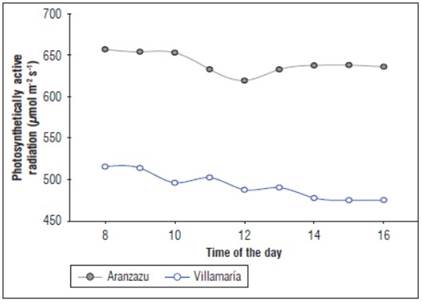
Figure 1. Incidence of photosynthetically active radiation at different times of the day in two contrasting zones of the Andean tropics of Caldas, Colombia.Aranzazu (latitude 5º18’40’’ N; altitude 1,900 m a.s.l.) with a semi-humid temperate climate, and Villamaría (latitude 5º01’05’’ N; altitude 2,400 m a.s.l.) classified as a humid cold climate.
The average PAR values of the two evaluated zones showed close data values ranging between 480 and 650 µmol m-2 s-1 for Villamaría and Aranzazu, respectively (Fig. 1), which despite not being very high values, meets the needs of the avocado tree considering that its light saturation point is between 500 and 1,200 µmol m-2 s-1 depending on the latitude and the growth stage of the tree (Bower, 1978; Scholefield et al., 1980).
The southern quadrant hadthe lowest PAR values over time, while the northern quadrant was constantly received higher values compared to the other quadrants (Fig. 2A). The Aranzazu area exhibited PAR values similar to those of Villamaría, with the northern quadrant maintaining high values throughout the day, while the southern and eastern quadrants tended to have the lowest incidence of PAR after midday (Fig. 2B). The highest PAR value in Villamaría was observed in the north quadrant at the 11:00 am with almost 1,000 µmol m-2 s-1 (Fig. 2A) and the highest PAR value observed in Aranzazu corresponded to the west quadrant at the 1:00 pm hour with 1,400 µmol m-2 s-1 (Fig. 2B).
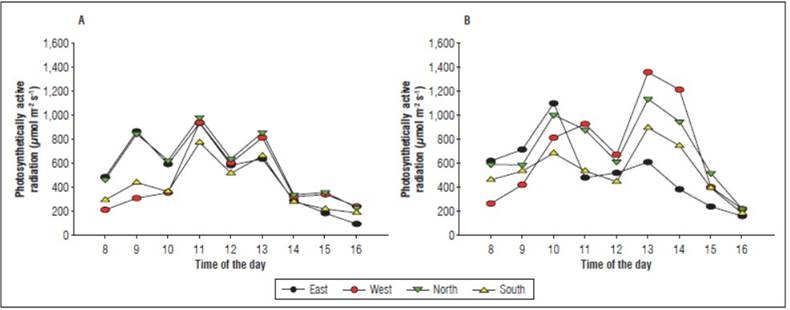
Figure 2. Incidence of photosynthetically active radiation per tree quadrant at different times of the day in two contrasting zones of the Andean tropics of Caldas, Colombia. A, Villamaría (latitude 5º01’05’’ N; altitude 2,400 m a.s.l.) classified as a humid cold climate; B, Aranzazu (latitude 5º18’40’’ N; altitude 1,900 m a.s.l.) with a semi-humid temperate climate.
The differences between the quadrants of the tree were marked. For both zones, the tendency was for a higher incidence of PAR on the north side during most of the day, a finding consistent with results reported by Bertling and Cowan (1998). Meanwhile, the east and west quadrants fluctuated over time. It was also common for the southern quadrant in both zones to have the lowest levels of PAR (Fig. 2A-B).
Due to Colombia’s proximity to the equator, photoperiods exhibit limited variations (Renner, 2007; Yeang, 2007). The photoperiod in Colombia averages a duration of 12 h, and its changes during the year are minimal. Therefore, the timing of sunrise and sunset and the earth’s inclinations at different times of the year directly favor the sun predominantly setting on the southwestern quadrant of the plantations. Furthermore, the substantial variations in PAR incidence throughout the day and the drastic drops in this incidence after 2:00 pm relate to the high levels of cloudiness present in the study areas due to their orography. The mountainous regions of the Colombian Andean tropics, coupled with current climate variability characterized by more frequent and longer periods of rain throughout much of the year, associated with the La Niña phenomenon (Martínez et al., 2011), contribute to frequent cloud cover that limits the capture of light by trees at different times of the day, particularly in the afternoon.
For the ambient temperature variable, the highest values were observed in the western quadrant in both zones, while the lowest values were observed at the southern quadrant in both locations (Fig. 3A). As for air humidity, the southern quadrant had the highest values in both two zones, while the lowest values were observed in the east in Aranzazu and the west in Villamaría (Fig. 3B).
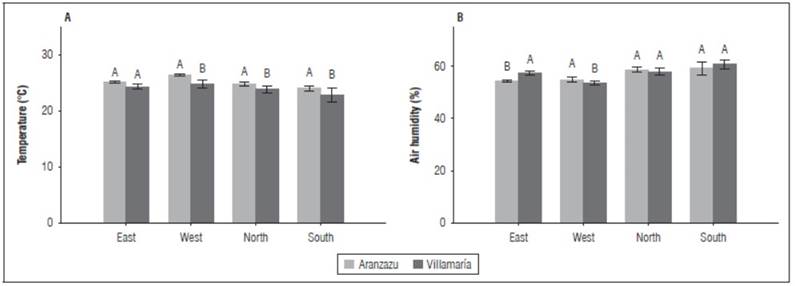
Figure 3. Pattern of ambient temperature (A) and air humidity (B) by tree quadrant in two contrasting zones of the Andean tropics of Caldas, Colombia. Means ± SE within a bar with different letters are significantly different (P<0.05).Aranzazu (latitude 5º18'40'' N; altitude 1,900 m a.s.l.) with a semi-humid temperate climate, and Villamaría (latitude 5º01'05'' N; altitude 2,400 m a.s.l.) classified as a humid cold climate. Means ± SE within a bar with different letters are significantly different (P<0.05).
The southern quadrant, which received the lowest levels of PAR, registered the lowest values in ambient temperature and the highest in air humidity, while the east and west sides had higher values for these climatic variables (Fig 3A-B). Understanding the microclimate of a plant is crucial for studying its productivity (Jones, 1985). In the case of 'Hass' avocado, for example, the stimulus for floral opening and its duration, pollen viability, stigmatic receptivity, among other processes, is strongly influenced by variables such as environmental temperature and air humidity in the specific zone where these reproductive organs emerge (Wang et al., 2007; Mditshwa et al., 2019; Alcaraz and Hormaza, 2021).
The fruit retention 60 days after anthesis (DAA) was greater in the Aranzazu area, with 250 fruits retained, while the Villamaría area retained just over 50 fruits. Between 60 DAA and 120 DAA, there was a massive abscission of fruits in both zones, with a greater number of fruits abscising in Villamaría. At that time in Aranzazu, there were about 100 fruits retained per tree, while in Villamaría there were only 14 fruits. Finally, at harvest, the trees in the Aranzazu area retained about 24 fruits, while trees in the Villamaría area retained only 7 fruits (Fig. 4).
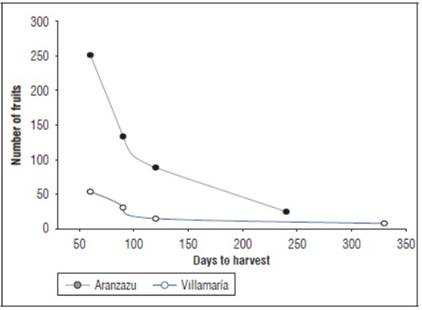
Figure 4. Fruit retention from 60 days after anthesis to harvest in two contrasting zones of the Andean tropics of Caldas, Colombia.Aranzazu (latitude 5º18'40'' N; altitude 1,900 m a.s.l.) with a semi-humid temperate climate, and Villamaría (latitude 5º01'05'' N; altitude 2,400 m a.s.l.) classified as a humid cold climate.
Indeed, early fruit drop is a reported occurrence in 'Hass' avocado (Boldingh et al., 2016; Garner and Lovatt, 2016; Silva et al., 2017), which aligns with observations from both study areas. However, the initial difference of 200 fruits between the areas at 60 DAA is significant. Observations indicate a higher proportion of lateral buds with reproductive fate in the Aranzazu zone, which suggests a higher proportion of flowers per tree. Consequently, it's logical that the initial proportion of fruits in the Aranzazu zone is higher than in Villamaría. However, this reproductive behavior might be directly related to the levels of photosynthetically active radiation (PAR) incidence in the trees of both zones (Abraha and Savage, 2010; Menzel and Le Lagadec, 2014; Wilkie et al., 2019). Considering that the levels were higher in the Aranzazu zone, this could potentially be associated with increased photosynthetic activity in the trees.
Sixty days after anthesis (DAA), the southern quadrant had the highest fruit retention values for both zones. At 120 DAA, the southern quadrant retained the most fruits in Villamaría, while in Aranzazu, the western quadrant had the highest values of fruit retention, 5 and 7 respectively. Finally, at harvest, only the southern quadrant of trees in the Villamaría area had retained fruit (Fig. 5A), while in Aranzazu, all quadrants had at least one fruit at harvest (Fig. 5B).

Figure 5. Fruit retention from 60 days after anthesis to harvest by tree quadrant in two contrasting zones of the Andean tropics of Caldas, Colombia. Villamaría (A), Aranzazu (B).Aranzazu (latitude 5º18'40'' N; altitude 1,900 m a.s.l.) with a semi-humid temperate climate, and Villamaría (latitude 5º01'05 N; altitude 2,400 m a.s.l.) classified as a humid cold climate.
Indeed, the trend of higher retention on the south side of both zones is maintained until harvest, with a 5% retention of the total initial fruit in the south quadrant of Villamaría and a 3% retention for the south and west quadrants in the Aranzazu zone (Fig. 5A-B). Given that the avocado is a species that evolved in understory conditions (Sharon, 1999), and the 'Hass' cultivar is a hybrid resulting from the Guatemalan and Mexican races (Bergh and Ellstrand, 1986), it's reasonable to suggest that 'Hass' avocado leaves have specific phyllotaxis making them shade-tolerant (Wolstenholme and Whiley, 1999; Chung et al., 2022). In addition, the canopy of avocado usually absorbs less than 50% of total incident radiation (Menzel and Le Lagadec, 2014). These factors could explain why even the quadrant with lower light incidence can retain fruits in quantities equal to or greater than those of the quadrants with higher light incidence, due to a maintenance of photosynthetic activity even with lower PAR incidence.
In terms of fruit characteristics, the final weight of the fruit was higher in the Villamaría area with an average of 230 g, compared to the 215 g registered in the Aranzazu area (Fig. 6A). The equatorial diameter also showed higher values in Villamaría (6.9 cm) compared to Aranzazu (6.6 cm) (Fig. 6B). Finally, the polar diameter in Villamaría was 9.5 cm, while in Aranzazu it was 8.6 cm (Fig. 6C). For all three variables related to fruit growth, Villamaría displayed higher values.
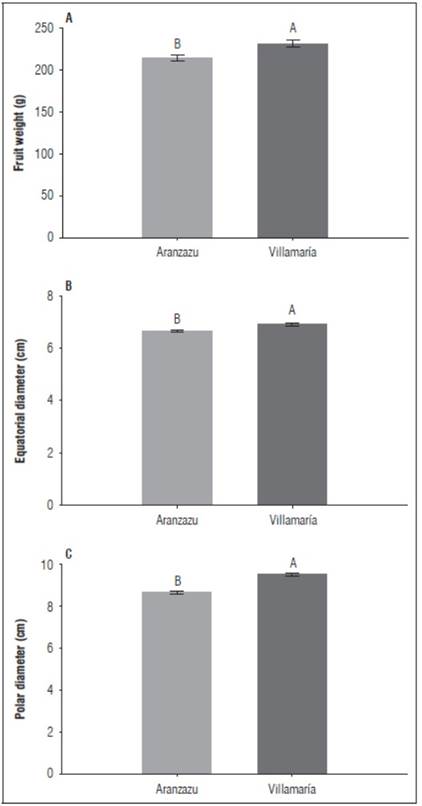
Figure 6. Average fruit weight (A), equatorial diameter (B) and polar diameter (C) in two contrasting zones of the Andean tropics of Caldas, Colombia.Aranzazu (latitude 5º18'40'' N; altitude 1,900 m a.s.l.) with a semi-humid temperate climate, and Villamaría (latitude 5º01'05'' N; altitude 2,400 m a.s.l.) classified as a humid cold climate.Means ± SE within a bar with different letters are significantly different (P<0.05).
This pattern can potentially be attributed to the environmental conditions in the respective areas. In colder regions, the duration of phenological stages tend to increase compared to areas with warmer temperatures (Rocha-Arroyo et al., 2011). Moreover, fruit quality also varies depending on the growing environment (Marques et al., 2006; Carvalho et al., 2015; Henao-Rojas et al., 2019; Fischer et al., 2022). Higher rainfall levels in the Villamaría area, greater water availability, and a greater number of shoots with vegetative fate in the same area, could be responsible for the observed patterns of final fruit growth compared to Aranzazu. However, it's important to note that the average weight and diameters obtained at each zone meet the standards required for the export market.
The final fruit weight observed in the Villamaría area was higher in both the east (240 g) and north (263 g) quadrants. In contrast, in the Aranzazu area, the quadrant displaying the lowest weight was the East, weighing in at 197 g, while the other quadrants of the tree showed similar values, which ranged between 216 and 218 g (Fig. 7A). Turning to the equatorial diameter variable, the Villamaría area boasted the highest values in the northern (7.29 cm) and eastern (7.0 cm) quadrants; meanwhile, in the Aranzazu area, the four quadrants presented similar average values, ranging between 6.5 and 6.7 cm (Fig. 7B). Lastly, an examination of the polar diameter in the Villamaría area revealed that the quadrant with the highest value was the North, measuring 10.11 cm, while in the Aranzazu area, the West side was marginally superior to the other quadrants, with a polar diameter of 8.87 cm (Fig. 7C).
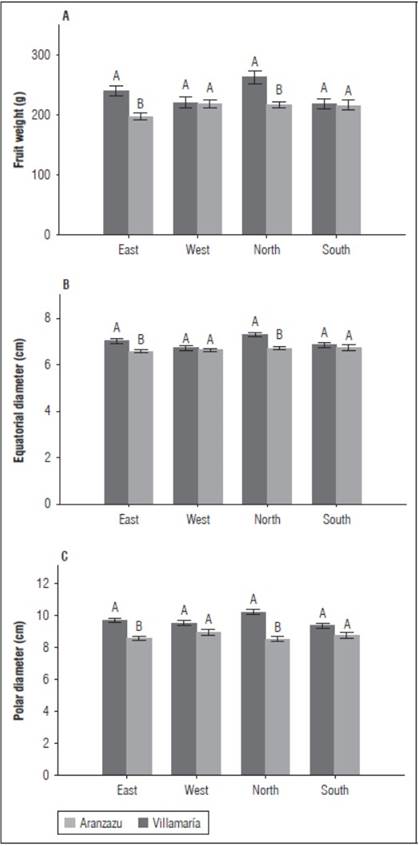
Figure 7. Average fruit weight per tree quadrant (A), equatorial diameter per quadrant (B) and polar diameter per quadrant (C) in two contrasting zones of the Andean tropics of Caldas, Colombia.Aranzazu (latitude 5º18'40'' N; altitude 1,900 m a.s.l.) with a semi-humid temperate climate, and Villamaría (latitude 5º01'05'' N; altitude 2,400 m a.s.l.) classified as a humid cold climate.Means ± SE within a bar with different letters are significantly different (P<0.05).
The final growth of the fruit per quadrant aligns with the findings of other researchers, who have suggested that the tree quadrants with higher light incidence and higher temperatures display the highest values in both shoot length and fruit weight (Bertling and Cowan, 1998; Dixon, 2007; Hofman and Jobin-Decor, 1999). However, it is important to emphasize that the incidence of radiation on the different quadrants of the tree is largely influenced by the geographical location of the orchard, resulting in potential differences between latitudes.
The macroscopic image of the fruit epidermis from the two zones indicates that Villamaría, at an altitude of 2,400 m a.s.l., has a smoother skin (Fig. 8B).On the other hand, the Aranzazu zone, at 1,950 m a.s.l., exhibits a greater number of protuberances (Fig. 8A). Additionally, the 3 × 3 cm image of the epidermis displays a surface in the Aranzazu area that is rough and classified as medium (Fig. 8C), whereas the surface roughness of the fruit in the Villamaría area is classified as low (Fig. 8D). The aforementioned trend in roughness is consistent in the cross-sectional image, with Villamaría showing a smooth skin (Fig. 8F) and Aranzazu featuring a rough skin (Fig. 8E). Lastly, the 2 mm microscopic image corroborates the presence of larger protuberances per unit area in the Aranzazu area (Fig. 8G), which is distinct from what is depicted in the image corresponding to the Villamaría area (Fig. 8H).
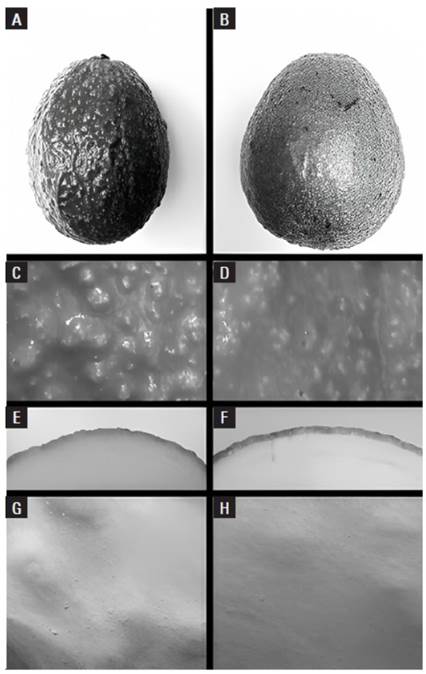
Figure 8. Macroscopic image of a 'Hass' avocado fruit (A-B), 3 × 3 cm image of the fruit epi-dermis (C-D), transversal image of the fruit skin and pulp (E-F), microscopic image of the fruit epidermis of 2 mm (G-H) from two contrasting areas of the Andean tropics of Caldas, Colombia. A. Aranzazu (latitude 5º18'40'' N; 75°29'13.1" W; altitude 1,900 m a.s.l.) with a semi-humid temperate climate, and B. Villamaría (latitude 5º01'05'' N; 75°29'54.9" W; altitude 2,400 m a.s.l.) classified as a humid cold climate.
The fruit's epidermis was found to be rougher in Aranzazu and smoother in Villamaría (Fig. 8A-B). Consequently, it appears that at lower temperatures and higher altitudes, the epidermis loses its roughness (Álvarez-Bravo and Salazar-García, 2017; Medina-Carrillo et al., 2017). In Colombia, the 'Hass' avocado is currently cultivated from 1,400 to 2,700 m a.s.l., leading to a great variation in the roughness of the fruit's epidermis that reaches international markets. Fruits with lower levels of roughness are accepted by current buyers. Moreover, producers suggest that fruits with fewer protuberances are less susceptible to lenticelosis, a phytopathology that restricts access to international markets.
Fruit retention in perennial species like avocado is intimately related to the effect of environmental factors on tree growth, particularly in the reproductive phase, and subsequently to the synthesis and distribution of photoassimilates and hormones to the different plant tissues. In this regard, the results of this research highlight important differences not only in the environmental conditions of the two altitudinally distinct zones, but also in the differential behavior at the reproductive level in both the trees and the quadrants within each zone.
This study augments our understanding of the effects that the microclimate exerts on the avocado tree canopy during reproductive stages, and its behavior based on the location of the structures in each tree quadrant. Additionally, it confirms that there are significant differences in the reproductive behavior of avocado under the conditions of the Andean tropics compared to other latitudes, and also between altitudes. Moving forward, it is advised to continue research that will deepen our understanding of the tree's productive behavior under specific environmental conditions. Such work could pave the way for studies geared towards the development of management plans tailored to these unique characteristics.
CONCLUSION
There exist differences in PAR incidence between locations and between quadrants of the tree, with the Aranzazu zone recording the highest PAR values, and the south and north quadrants of the two zones exhibiting the lowest and highest incidence, respectively.
Fruit retention until harvest amounted to 5% in the southern quadrant in Villamaria (2,400 m a.s.l.) and 3% for the southern and western sides in Aranzazu (1,900 m a.s.l.).
Fruit retention until harvest amounted to 5% in the southern quadrant in Villamaria (2,400 m a.s.l.) and 3% for the southern and western sides in Aranzazu (1,900 m a.s.l.).















